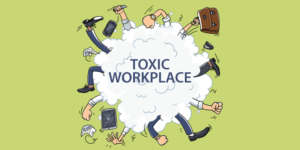- Lack of Communication and Transparency – One of the primary drivers of toxicity in any setting is a lack of open and transparent communication. When information is withheld, rumors spread, and people feel excluded or uninformed, it can lead to confusion and resentment. The absence of clear communication channels can breed mistrust and dissatisfaction, contributing to an overall toxic environment.
- Negative Gossip and Backbiting – Engaging in negative gossip and backbiting can quickly poison the atmosphere. When individuals focus on spreading rumors, belittling others, or talking behind people’s backs, it creates an environment of mistrust and insecurity. Such behavior erodes relationships and sows the seeds of discord among team members or friends.
- Unhealthy Competition – Healthy competition can be motivating, but when it takes a toxic turn, it can damage relationships and create a hostile environment. Cutthroat competition, where individuals are willing to undermine colleagues or peers to get ahead, breeds a sense of insecurity and hostility. This environment can be detrimental to collaboration and the overall success of a team or group.
- Bullying and Harassment – Bullying and harassment, whether overt or subtle, can create an extremely toxic environment. Such behavior not only affects the victims but also undermines the overall morale of a group. People in such environments may fear speaking up or challenging the status quo, leading to a stifling atmosphere where creativity and growth are hampered.
- Lack of Empathy and Respect – When individuals fail to empathize with others’ feelings and perspectives, it can lead to a hostile environment. Disrespectful behavior, whether in the form of dismissive attitudes, derogatory comments, or discriminatory actions, breeds negativity and resentment. A lack of empathy makes it difficult for individuals to connect and collaborate effectively.
- Micromanagement and Authoritarianism – A toxic environment often flourishes when there’s a lack of trust and excessive micromanagement. When individuals are constantly scrutinized, their autonomy is undermined, leading to frustration and demotivation. Authoritarian leadership styles can stifle creativity, innovation, and a sense of ownership among team members.
- Unresolved Conflicts – Ignoring or mishandling conflicts can create an environment of tension and discomfort. Unresolved disputes can fester over time, leading to strained relationships, resentment, and a lack of cohesion within the group. Addressing conflicts openly and finding constructive solutions are essential to preventing toxicity from taking root.
https://www.themuse.com/advice/toxic-work-environment
https://www.workhuman.com/blog/toxic-work-culture-environment/

